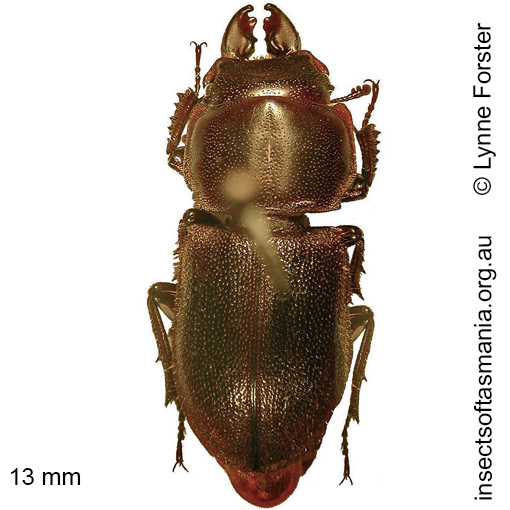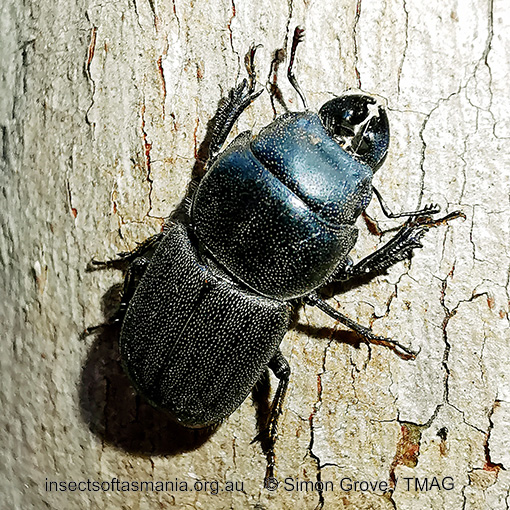
Lissotes cancroides (a species of stag-beetle)
Basis for Tasmanian occurrence
Classification
Suborder: Polyphaga
Superfamily: Scarabaeoidea
Family: Lucanidae
Subfamily: Lucaninae
Morphology
Flightedness: functionally flightless
Source literature on morphology and taxonomy (*primary taxonomic source, where identified):
Hangay, G. & de Keyzer, R. (2017). A guide to stag beetles of Australia. Clayton, VIC: CSIRO publishing, 245 pp.
Ecology
Association with dead wood or old trees: obligately saproxylic
Ecological attributes: — Eucalyptus obliqua is a host-plant (Bashford, 1990a) — Nothofagus cunninghamii is a host-plant (Bashford, 1990a) — Affiliated with intermediate-aged (ex-clearfelled) forest (Michaels, 1999) — Affiliated with lowland (<500 m altitude) wet forest (Forster & Grove, 2009) — Associated with brown discoloured wood (Yee et al., 2006) — Associated with fibrous surface rot (Yee et al., 2006) — Associated with mudguts (Yee et al., 2006) — Associated with white jelly surface rot (Yee et al., 2006) — Found in logging-regenerated and mature (unlogged) forest (Michaels & Bornemissza, 1999) — Found under large logs (Grove et al., 2006) — May occupy logs or trunks of Eucalyptus obliqua, at least temporarily, since found having emerged within a year of felling (Grove & Bashford, 2003) — May occupy logs or trunks of Eucalyptus obliqua, at least temporarily, since found having emerged within six years of felling (Grove et al., 2009).
Collection method(s) for TMAG material: — Emergence trapping from cut billets of Eucalyptus obliqua (Harrison, 2007) — Emergence trapping from log of Eucalyptus obliqua — Flight intercept trapping (trough below Malaise trap) — Hand collection (substrate not specified) — Hand collection from under log (tree species not specified) — Knockdown fogging of canopy of Nothofagus cunninghamii — Malaise trapping — Pitfall trapping — Trunk window trapping (Harrison, 2007).
Source ecological literature:
Grove, S.J. & Bashford, R. (2003). Beetle assemblages from the Warra log decay project: insights from the first year of sampling. Tasforests 14: 117-129.
Grove, S.J. (2009b). Beetles and fuelwood harvesting: a retrospective study from Tasmania’s southern forests. Tasforests 18: 77-99.
Grove, S.J. et al. (2006). What lives under large logs in Tasmanian eucalypt forest? Tas. Nat. 128: 86-93.
Yee, M. et al. (2001). Not just waste wood: decaying logs as key habitats …: the ecology of large and small logs compared. Tasforests 13: 119-128.
Baker, S.C. (2000). Forest litter beetles and their habitat: a comparison of forest regenerated by wildfire and logging practices. Hons. thesis, Univ. of Tasmania, Hobart.
Baker, S.C. (2006b). Ecology and conservation of ground-dwelling beetles in managed wet eucalypt forest: edge and riparian effects. PhD thesis, Univ. of Tasmania, Hobart.
Bashford, R. (1990a). Tasmanian forest insects and their host plants: records from the Tasmanian Forestry Commission insect collection. Hobart: Tas. Forestry Commission, 32 pages.
Grove, S. et al. (2009). A long-term experimental study of saproxylic beetle … succession in Tasmanian Eucalyptus … logs… In: Fattorini, S. (Ed.), Insect Ecology and Conservation. Research Signpost, pp. 71-114.
Harrison, K.S. (2007). Saproxylic beetles associated with habitat features in Eucalyptus obliqua trees in the southern forests of Tasmania. PhD thesis, Dept. of Zoology, Univ. of Tasmania, Hobart.
Michaels, K.F. & Bornemissza, G. (1999). Effects of clearfell harvesting on lucanid beetles (Coleoptera: Lucanidae) in wet and dry sclerophyll forests in Tasmania. J. Insect Cons. 3: 85-95.
Michaels, K.F. (1999a). Carabid beetles as biodiversity and ecological indicators. PhD thesis, Univ. of Tasmania, Hobart.
Taylor, R.J. (1990). Occurrence of log-dwelling invertebrates in regeneration and oldgrowth wet sclerophyll forest in southern Tasmania. Pap. Proc. Roy. Soc. Tas. 124: 27-34.
Yee, M. (2005). The ecology and habitat requirements of saproxylic beetles native to Tasmanian wet eucalypt forests: potential impacts of commercial forestry practices. PhD thesis, Univ. of Tasmania, Hobart.
Yee, M. et al. (2006). Brown rot in inner heartwood: why large logs support characteristic … beetle assemblages … In Grove, S.J. & Hanula, J.L. (eds.) Insect biodiv. and dead wood, pages 42-56. USDA For. Serv., SRS.


